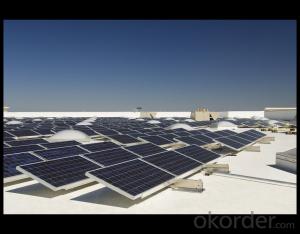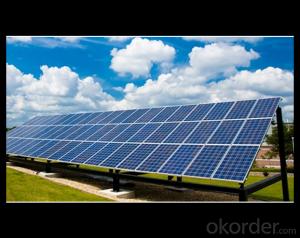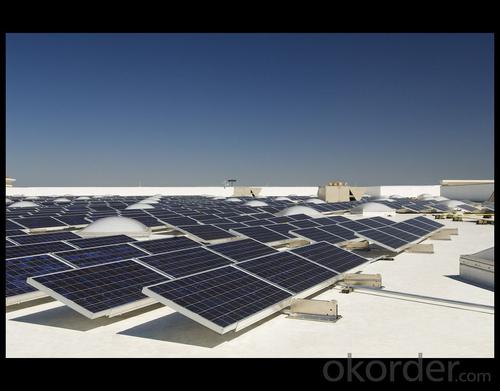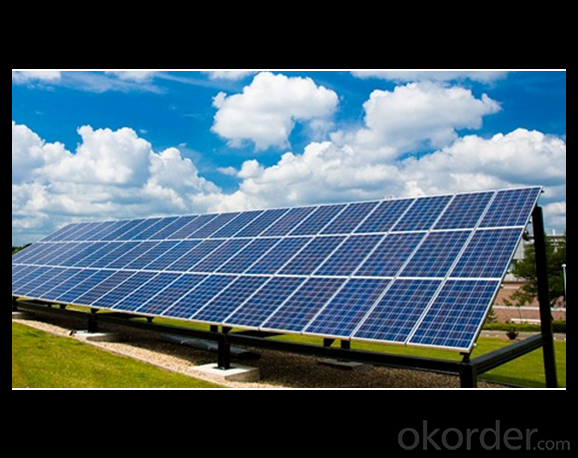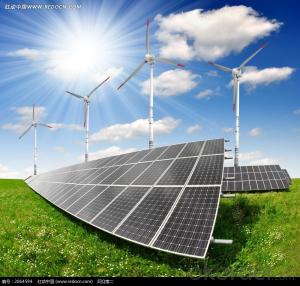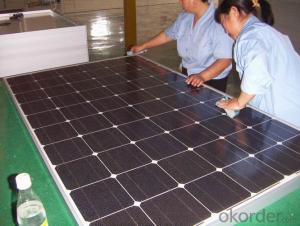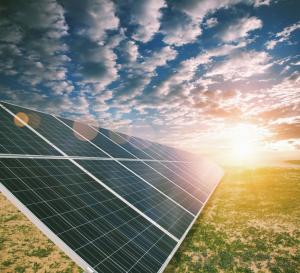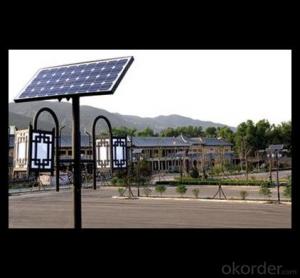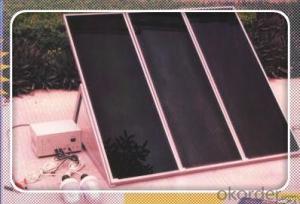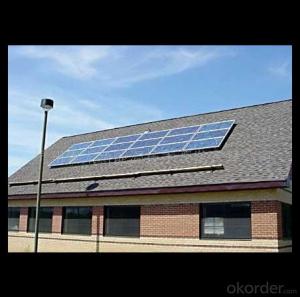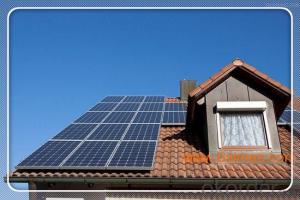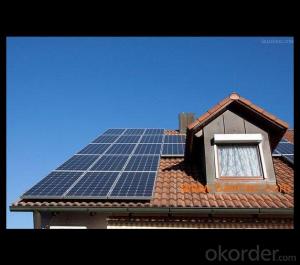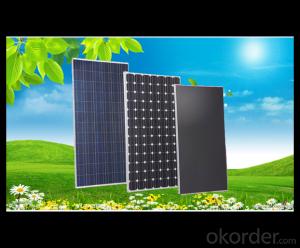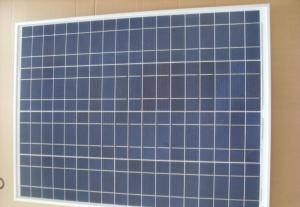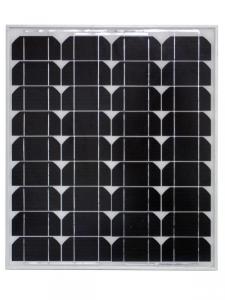Stock Solar Panels - 50w Direct Factory Sale Price 260-300watt Solar Panels
- Loading Port:
- China main port
- Payment Terms:
- TT OR LC
- Min Order Qty:
- 10000 watt
- Supply Capability:
- 100000 watt/month
OKorder Service Pledge
OKorder Financial Service
You Might Also Like
Specification
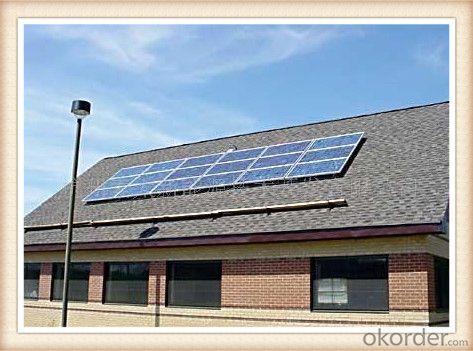
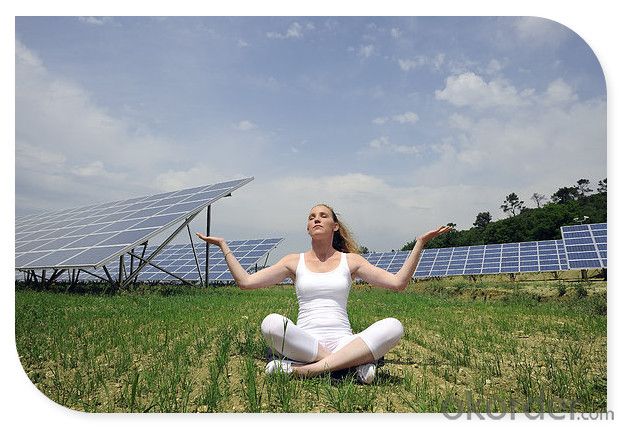
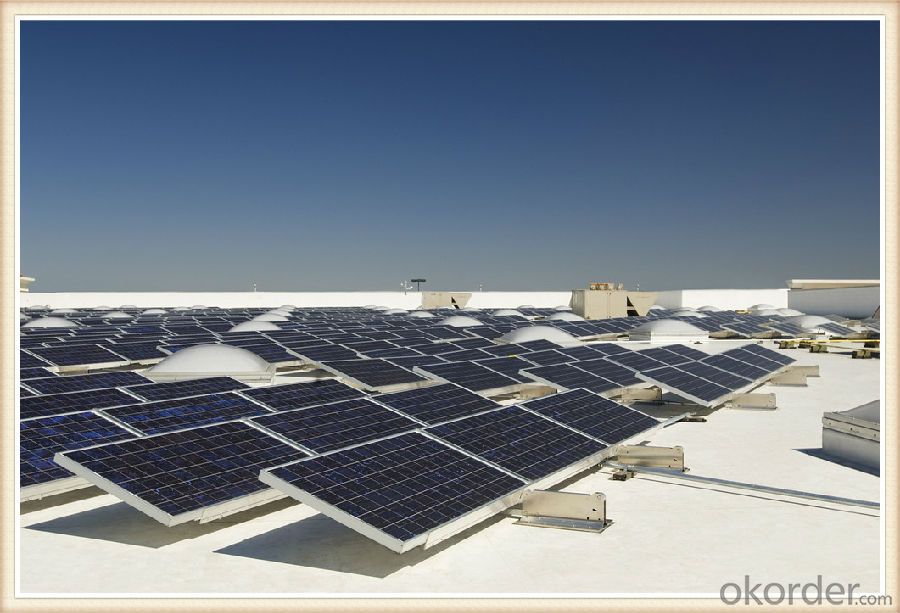
Solar Module Introduction
Solar modules use light energy (photons) from the sun to generate electricity through the photovoltaic effect. The majority of modules use wafer-based crystalline silicon cells or thin-film cells based on cadmium telluride or silicon. The structural (load carrying) member of a module can either be the top layer or the back layer. Cells must also be protected from mechanical damage and moisture. Most solar modules are rigid, but semi-flexible ones are available, based on thin-film cells. These early solar modules were first used in space in 1958.
Electrical connections are made in series to achieve a desired output voltage and/or in parallel to provide a desired current capability. The conducting wires that take the current off the modules may contain silver, copper or other non-magnetic conductive transition metals. The cells must be connected electrically to one another and to the rest of the system. Externally, popular terrestrial usage photovoltaic modules use MC3 (older) or MC4 connectors to facilitate easy weatherproof connections to the rest of the system.
Specification
Model Type | |
Peak Power-Pmax(W) | 5-200W |
Open Circuit Voltage-Voc(V) | 44.2 |
Maximum Power Voltage-Vmp(V) | 36 |
Short Circuit Current-Isc(A) | 5.4 |
Maximum Power Current-Imp(A) | 5 |
Maximum System Voltage | 1000V DC |
Maximum Series Fuse Rating | 10A |
Power Tolerance | -1~+3% |
Temperature Coefficients of Pmax | -0.45%/℃ |
Temperature Coefficients of Voc | -0.348%/℃ |
Temperature Coefficients of Isc | 0.031%/℃ |
Nominal Operating Cell Temperature | 44.5±2℃ |
Standard Testing Condition(STC) | Irradiance:1000W/m²;Temperature:25℃;AM=1.5 |
Qualification Test Parameters | |
Operating Temperature | -40℃~+85℃ |
Storage Temperature | -40℃~+85℃ |
Pressure Bearing | ≥5400Pascal/m² |
Wind Bearing | ≥5400Pascal/m² |
Mechanical Characteristics | |
Cell Size | Mono 125*125mm±0.5 |
No.of Cells | 72pcs(6*12) |
Dimension | 1580*808*40mm |
Weight | 15.5Kg |
Glass | 3.2mm High Transmission,Low Iron |
Frame | Anodized Aluminum Alloy |
Junction Box | IP65Rated |
Internal Diodes | 3 Bypass Diodes |
Cable | 1*4.0mm² Length 900mm |
Images
Packing & Shipping:
We have rich experience on how to pack the panels to make sure the safety on shipment when it arrives at the destination.
The normal size is packed by 25pcs/ carton / pallet. Paper carton for FCL shipping and wood carton for LCL shipping.
Features
1.High reliability with guaranteed -3% to +5% power output tolerance, ensuring return on investment
2.High conversion efficiency based on leading innovative photovoltaic technologies
3.Withstands high wind-pressure and snow load, and extreme temperature variations
4.Attractive appearanceUnique frame design, high mechanical strength, and easy Installation
Warranty:
For c-Si panel: 25years output warranty for no less than 80% of performance, 10 years output warranty for no less than 90% of performance. Free from material and workmanship defects within 5 years.
For a-Si panel: 20 years output warranty for no less than 80% of performance, 10 years output warranty for no less than 90% of performance. Free from material and workmanship defects within 2 years.
•100% product quality protection
•100% on-time shipment protection
•100% payment protection for your covered amount
FAQ:
(1)What price for each watt?
It depends on the quantity, delivery date and payment terms.
(2)What is your size for each module? Can you tell me the Parameter of your module?
We have different series of panels in different output, both c-Si and a-Si. Please take the specification sheet for your reference.
(3)Can you provide the peripheral products of the solar panels, such as the battery, controller, and inverter? If so, can you tell me how do they match each other?
Actually we are only manufacturer of solar panels, but we could try to source them for you in China if you need. We could provide you an optimal system design to instruct you how to install.
(4)Do you have the CE, TUV, UL Certification?
We’ve already passed all the tests, and any certificate is available.
(5)Have you ever sold your products to companies in my country?
Of course, we have customers in all general PV markets, but I think we should expand our market share along with the market growth.
(6)When did your company set up? You are a new company, how can I believe your quality?
We entered into Solar PV industry in 2005, now we have several plants in manufacturing of a-Si and c-Si panels, and our capacity is 220MW per year. Till now we have already passed all the tests by authorized laboratories, e.g. TUV, VDE, UL.
(7)Can you help us install the module if we cooperate with you?
We haven’t entered into installation sector, but we have the plan in near future.
(8) How do you pack your products?
We have rich experience on how to pack the panels to make sure the safety on shipment when it arrives at the destination.
(9) Can you do OEM for us?
Yes, we can.
(10)Can we visit your factory?
Surely, I will arrange the trip basing on your business schedule.
- Q: Why might energy from the solar panels sometimes be near zero even in the summer?
- Hey Cosmic, forget about Wayfare and Jenny here, but I have to say your question is a bit vague. When you say the panels produce near zero, how near? Are you using a watt meter, ammeter, or some other sort of metering device. Solar electric, or photovoltiac panels are made almost entirely of silicone wafers. Same as computer chips, when they get hot, the resist the flow of electrons. This is why most panel manufacturers advise installers to upgauge wiring if the temperature falls below 40 degrees F (5C) regularly. Below 0 C, you have to upgauge 2 wire sizes. A good quality panel will put out 50% of its rated power in very cold climates, so it stands to reason that they will put out substantially less in hot weather. Many people think places like the SW United States is great for solar because it's always sunny. In Las Vegas for example, they have 27 sunny days a month, and in August, the temperature frequently reaches 50 degrees C (20F) so people with photovoltiac panels are not even getting half their rated power on a good day. I'm not sure this is what you are asking about. Our home has been powered by the wind and sun for 2 years now. In the summer in the upper midwest, the days are warmer of course, but also much longer than in the winter. So our batteries will frequently fill up by 2:00pm, and the charge controller will taper off the solar charging the rest of the day to minimize overcharging. If you were to check the meters at 3pm, you might notice only 3 or 4 amps coming in when the array is rated at 42. This is normal for us in July and August. These are some reason why a solar array produces near zero in the summertime. Take care Cosmic, Rudydoo
- Q: Do solar panels require maintenance?
- Yes, solar panels do require maintenance. Regular cleaning to remove dirt, dust, and debris is necessary to ensure optimal efficiency. Additionally, periodic inspections and maintenance checks are recommended to identify and address any potential issues such as loose connections, wiring problems, or shading that may affect performance. However, compared to other forms of energy generation, solar panels require relatively low maintenance efforts.
- Q: I heard the wind turbines, solar panels so far provide America with around 2% of our energy. So since liberals appear to want to replace natural energy with man made products, that cause massive pollution by the way to make- How long will that take 30 years, 00 years? How many Wind Turbines will Airplanes and birds and parachute jumpers smash into, isn't that a problem? How do we rid of natural energy before we have the LIBERAL BACK UP PLAN - WE DON'T REALLY HAVE ? How do they think this is gonna work? Its not logical, we need to come up with more ideas! That Battery idea kinda sucks since Batteries Need natural energy to work.
- Both the wind turbines ( windmills) and solar panels are less costly to implement than nuclear power and have less disaster potential. They have proven that Windmills miles out in the ocean are a great source of power. This dose not consume any land. For land bound areas they should use public roadways to line the windmills. For areas without sustainable winds they can use the combined effect of windmills and solar power. Honey, any motor needs oil. Whether it is a generator for a windmill or a nuclear reactor. Motors are what runs the world. Consider the amount of oil to run a nuclear facility. Tons more than a generator motor. Once a turbine is activated (motor started) the winds themselves turns the windmill. Each turbine is lined up with the next (wind farms) to push wind at the blades, they each push each other.
- Q: a) i'd like to get a solar panel to make this thing i saw in popular science, it was a bag that had a solar panel in the side (you just attach it with grommets into a clear vinyl pocket you make. its for charging elecronics and stuff) and i was wondering what kind i should look at, do they come flexible? can i get them on OKorder? what kind of wattage should i look for (btw it also had a little voltage regulator and stuff to make a little usb in your bag) so any info on that!b) i was thinking about like putting solar panels on my roof, where can i look into that, is that a good choice, has anyone done it, how did it work out? thank you, just curious
- For okorder / for information on how to hooke it up your self. It is a DIY site.
- Q: K i'm almost ready to give up! I've bought every kind of pv I can think of, and I can see this technology will not be affordable in my lifetime.I conserve all I can (so far as to handwashing my laundry etc) I'm not rich, but I'm saving for a solar pv with decent amperage. I love tinkering with things if I see the point.All the cells i've seen are very weak. What PV would you buy? (all I need is to power my computer from a deep cycle 2 volt battery connected to an inverter)God Bless You
- Solar okorder /
- Q: Can solar panels be installed on a sports stadium?
- Yes, solar panels can be installed on a sports stadium. In fact, many stadiums around the world have already adopted solar energy systems to generate electricity and reduce their carbon footprint. These panels are typically installed on the roof or in parking lots surrounding the stadium, taking advantage of the large surface area available. Installing solar panels on a sports stadium not only helps in generating clean energy but also serves as a visible statement of the stadium's commitment to sustainability.
- Q: How do solar panels impact wildlife?
- Solar panels can have both positive and negative impacts on wildlife. On the positive side, solar panels provide clean and renewable energy, reducing dependence on fossil fuels and mitigating climate change, which can have indirect benefits for wildlife populations. Additionally, solar panels can create new habitats for certain species, such as birds, by providing perching and nesting opportunities. However, there are also potential negative impacts to consider. Solar farms can disrupt and fragment natural habitats, displacing or causing harm to certain species. Birds may be at risk of collision with solar panels, although proper installation and design can help mitigate this issue. To minimize these negative impacts, it is important to carefully plan and design solar projects, taking into account wildlife conservation and habitat protection measures.
- Q: Can solar panels be installed in areas with high wind speeds?
- Yes, solar panels can be installed in areas with high wind speeds. However, it is important to ensure that the solar panels are designed and installed to withstand the specific wind conditions of the area. This may involve using appropriate mounting systems and anchoring techniques to secure the panels effectively. Additionally, regular maintenance and inspections should be conducted to ensure the panels remain secure and efficient in such conditions.
- Q: Can solar panels be installed on windows or glass surfaces?
- Yes, solar panels can be installed on windows or glass surfaces. These are known as building-integrated photovoltaics (BIPV) and are designed to replace traditional building materials such as windows, skylights, or facades with solar panels. BIPV systems are a great way to generate electricity while maximizing space and utilizing underutilized surfaces.
- Q: Can solar panels be installed on a community center or recreational facility?
- Yes, solar panels can be installed on a community center or recreational facility. Solar panels can provide renewable energy for the building, reducing reliance on fossil fuels and lowering energy costs. Additionally, it can serve as an educational opportunity for the community to learn about sustainable energy practices.
Send your message to us
Stock Solar Panels - 50w Direct Factory Sale Price 260-300watt Solar Panels
- Loading Port:
- China main port
- Payment Terms:
- TT OR LC
- Min Order Qty:
- 10000 watt
- Supply Capability:
- 100000 watt/month
OKorder Service Pledge
OKorder Financial Service
Similar products
Hot products
Hot Searches
Related keywords
